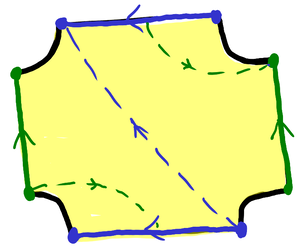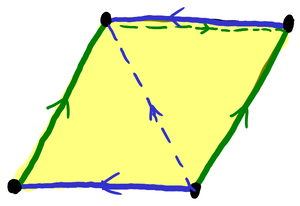Fibering of the trefoil knot complement
I’ve found myself re-calculating the fibration of the trefoil knot complement again, so I thought I’d write a short note this time to record it. The main technique is the elastic cord criterion from
Sebastian Baader and Christian Graf, Fibred links in S^3, Expo. Math. 34 (2016), no. 4, 423–435. doi:10.1016/j.exmath.2016.06.006 MR 3578006
What is a fibered knot?
An oriented knot (or link) K\subset S^3 is called a fibered knot if the knot complement S^3-K can be given the structure of a fibration over S^1 such that the closure of each leaf is a compact oriented surface whose boundary is K with the correct induced orientation. In other words, there is a smooth map f:S^3-K\to S^1 with no critical points such that the closure of f^{-1}(\theta) is a Seifert surface for K for each \theta\in S^1. Letting \Sigma=f^{-1}(0) be one of the fibers, circle-valued functions like this generate a smooth map \mu:\Sigma\to\Sigma called the monodromy, which is obtained through gradient flow: we can use df to pull d\theta back to S^3-K then use the metric to form a non-vanishing vector field, and then \mu(x) is given by an integral curve starting at x then seeing where it ends up at time t=2\pi. The monodromy lets us regard S^3-K as a mapping cylinder of \Sigma:
\begin{align*}
S^3-K \approx (\Sigma\times [0,1])/({(\mu(x),0)\sim (x,1)})
\end{align*}The knot exterior (the complement of a tubular neighborhood of K) is given by the same mapping cylinder construction but with a compact oriented surface. In the above construction, one can arrange for the monodromy to be the identity in a neighborhood of K since, near K, the flow of a point in \Sigma gives a meridian loop:

The main takeaway of all this is that “calculating the fibering” amounts to giving the following data: (1) a compact oriented surface \Sigma and (2) a smooth map \mu:\Sigma\to\Sigma that is the identity when restricted to the boundary.
Since it’s the identity on the boundary, the map extends to a smooth map of a closed oriented surface obtained by collapsing each boundary curve to a point. From this point of view, the data is (1) a closed oriented surface \Sigma with a finite collection of points and (2) a smooth map \mu:\Sigma\to\Sigma that fixes each point in the collection. Incidentally, this gives a fibering of the 0-surgery of the knot or link.
What is the elastic cord criterion?
Let’s consider the case of a knot exterior, so \Sigma is compact. An observation for a fibration is that if you find a cut set of arcs for \Sigma, you can flow the arcs themselves from \Sigma to \Sigma, giving properly embedded squares [0,1]\times[0,1] in \Sigma\times[0,1] such that {0,1}\times[0,1] is embedded “vertically”, and the complement of the squares in \Sigma\times[0,1] is a disjoint union of open balls.
Conversely, given a (connected[1]) Seifert surface \Sigma for an oriented knot (or link) K, if one can find a cut set of arcs for \Sigma along with disjoint properly embedded squares in S^3-\nu(K) whose “vertical” boundaries are meridians for K, then because knot complements are irreducible the complement of the union of \Sigma and the squares is a disjoint union of open balls, and hence K is fibered.
It turns out that you don’t need to actually worry about the disks themselves. The elastic cord criterion is that a knot (or link) K is fibered if and only if there is a Seifert surface with a cut set such that, with the arcs being thought of as “elastic cords” attached to the boundary on one side of the surface, they can be dragged to the other side. The monodromy is determined by where the cords end up. (Also, if there is any arc that, as an elastic cord, cannot be dragged to the other side, the knot is not fibered.)
Here’s an attempt at illustrating an elastic cord (blue thick line) being dragged in the direction of the green arrows to the other side of the surface (dashed blue thick line), with a portion of the square it is dragged through:

The trefoil knot
The (right-handed) trefoil knot has a genus-1 Seifert surface from taking one of the two checkerboard surfaces from a standard diagram. Here’s an illustration of the Seifert surface (yellow is the front side, gray is the back), a cut set of arcs given by the blue and green curves, and the the result of taking the arcs as elastic cords and dragging them to the other side of the surface:





The lattice of lifts of the ideal point can be described as \Z[\omega]\subset\C with \omega=e^{\pi i/3}, and then the covering map is given by \C modulo \Z[\omega] as abelian groups. The action of \omega^{-1} on \C by multiplication descends to the quotient, which is a torus. The image of 0 is fixed by the action and corresponds to the ideal point.
Using the \{1,\omega\} coordinate system, the matrix of the \omega^{-1} action is
\begin{align*}
\begin{bmatrix}
1 & 1 \\
-1 & 0 \\
\end{bmatrix}
\end{align*}The left-handed trefoil knot is similar, but instead the monodromy corresponds to a 60 degrees counterclockwise rotation.